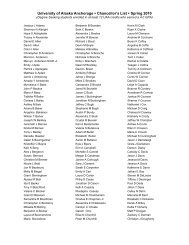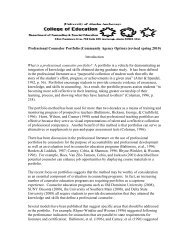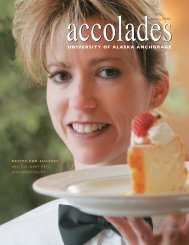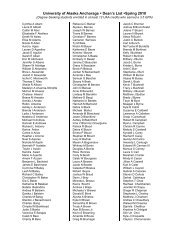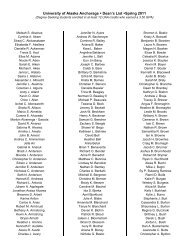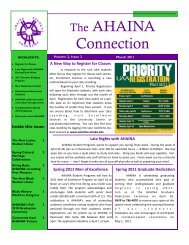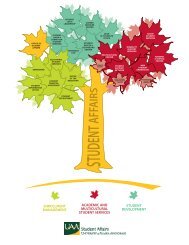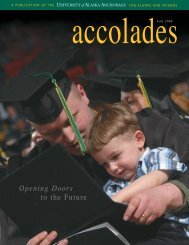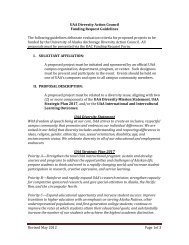How to support people with repetitive and “stuck” - University of ...
How to support people with repetitive and “stuck” - University of ...
How to support people with repetitive and “stuck” - University of ...
You also want an ePaper? Increase the reach of your titles
YUMPU automatically turns print PDFs into web optimized ePapers that Google loves.
<strong>How</strong> <strong>to</strong> <strong>support</strong> <strong>people</strong><br />
<strong>with</strong><br />
<strong>repetitive</strong> <strong>and</strong> <strong>“stuck”</strong> behavior<br />
Nathan E. Ory, M.A.<br />
Ful Lives Conference<br />
24 April 2009<br />
Anchorage, Alaska
Questions <strong>to</strong> ask about<br />
Persistent, <strong>repetitive</strong> behavior<br />
P What is just something <strong>to</strong> do?<br />
< Time-filling activity. Sensory self-stimulation.<br />
P What is behavioral?<br />
< Learned habits <strong>and</strong> rituals. Somehow functional.<br />
P What is neurological?<br />
< Brain-based. Person may not be able <strong>to</strong> selfinitiate<br />
a shift <strong>of</strong> attention, or start/s<strong>to</strong>p a<br />
behavioral sequence.<br />
P What is psychiatric?<br />
< Obsessive-compulsive, anxiety controlling.
Different functions <strong>of</strong><br />
persistent, <strong>repetitive</strong> behavior<br />
P Overcoming insecurity/uncertainty through ritual.<br />
< Comforted by familiar, well rehearsed rituals.<br />
<<br />
<<br />
<<br />
Repeatedly asks questions till answered!<br />
Emotional-behavioral.<br />
Exaggerated by anxiety.
Different functions <strong>of</strong><br />
persistent, <strong>repetitive</strong> behavior<br />
P Overcoming lack <strong>of</strong> internal boundaries.<br />
< Constant “limit testing,” looking for predictability.<br />
<<br />
<<br />
<<br />
With clear, external limits, no testing.<br />
Emotional-behavioral.<br />
Exaggerated by anxiety.
Different functions <strong>of</strong><br />
Persistent, <strong>repetitive</strong> behavior<br />
P Obsessive thoughts - compulsive behavior<br />
< Can’t move on, even <strong>with</strong> prompts.<br />
<<br />
<<br />
<<br />
<<br />
<<br />
Resists interruption.<br />
Stuck in thought-action.<br />
Overwhelmed by thoughts that produce anxiety.<br />
Psychiatric.<br />
Exaggerated by anxiety.
Different functions <strong>of</strong><br />
persistent, <strong>repetitive</strong> behavior<br />
P M aintaining personal continuity.<br />
< Linking our actions in space <strong>and</strong> time.<br />
P O vercoming “discontinuity”, inability <strong>to</strong> sequence.<br />
< Repeating acts keep one’s place in time <strong>and</strong> space.<br />
<<br />
<<br />
<<br />
With external structure, moves on.<br />
Cognitive-neurological-behavioral.<br />
Exaggerated by anxiety
Functional-”continuity” behaviors<br />
Self-anchoring rituals<br />
P- sensory-tactile:<br />
< smelling, <strong>to</strong>uching, licking, spitting, masturbating,<br />
eating, self-injurious acts (e.g., scratching.)<br />
P- kinesthetic:<br />
< rocking, flapping, jumping<br />
P-<br />
<<br />
visual-spatial:<br />
ordering objects, alphabatizing, making lists,<br />
cataloguing, word search
Functional “continuity” behaviors<br />
Self-anchoring rituals<br />
P - social:<br />
< attacking wrong doers,<br />
– keeping the "rules."<br />
P verbal:<br />
< <strong>repetitive</strong> speech, sing-song,<br />
–<br />
–<br />
echoing, vocalizing<br />
asking questions.
Functional “continuity” behaviors<br />
Self-anchoring rituals<br />
P - cognitive/mental:<br />
< - replays <strong>of</strong> videotapes, rereading s<strong>to</strong>ries, copying<br />
“ old” schoolwork.<br />
< - verbal rehearsal <strong>of</strong> the activity <strong>of</strong> the day<br />
< - verbal rehearsal <strong>of</strong> the "rules",<br />
< - single minded pursuit <strong>of</strong> questions <strong>to</strong> end.<br />
P - emotional:<br />
< - mental rehearsal <strong>of</strong> confusions-wrongs<br />
< -"obsessive"<br />
talking about anxiety evoking <strong>to</strong>pics<br />
< -<br />
just for fun
Behavioral characteristics <strong>of</strong><br />
Perseverative Responding<br />
Behaviors are persistent, <strong>and</strong> <strong>repetitive</strong>, but<br />
reflecting neurological disorder, <strong>and</strong>/or <strong>with</strong>out<br />
any apparent functional value.<br />
"Perseverative responding" reflects deficits in<br />
a person's ability <strong>to</strong> self-initiate, self-organize,<br />
self-sequence <strong>and</strong> regulate his/her own<br />
actions <strong>and</strong> thoughts.
Different functions <strong>of</strong><br />
perseverative behavior<br />
NONE<br />
P Actions have no “functional” value.<br />
< Person is <strong>“stuck”</strong> in action, thought, sensation.<br />
<<br />
<<br />
<<br />
With prompt, can move on. Cue dependent <strong>to</strong> shift.<br />
Neurological.<br />
Exaggerated by anxiety.
Some diagnostic categories showing<br />
perseverative responding<br />
P Developmental brain dysfunctions<br />
< Fetal alcohol spectrum disorders<br />
< Anoxia at birth, cerebral palsy, seizures, tuberous<br />
sclerosis, arrested hydrocephaly<br />
P Acquired Traumatic Brain Injury<br />
P Genetic Syndromes:<br />
< Fragile X, Prader-Willie, Williams Syndrome<br />
P Pervasive Developmental Disorders<br />
< Autistic spectrum disorders<br />
P Dementias<br />
P<br />
Psychiatric disorders
Indica<strong>to</strong>rs that<br />
persistent, <strong>repetitive</strong> behaviors are<br />
Perseverative responding<br />
PPerson appears <strong>to</strong> have no self-control over<br />
<strong>repetitive</strong> behaviors. Person gets "stuck in a<br />
rut" <strong>and</strong> can not shift activity on his own<br />
initiative.<br />
PPerson is dependent upon a caregiver <strong>to</strong><br />
assist him <strong>to</strong> mediate his experiences.<br />
PSomething reliably “works” <strong>to</strong> bring <strong>repetitive</strong><br />
behavior <strong>to</strong> an abrupt halt.<br />
< “S<strong>to</strong>ps on a dime” “Switches channels”
Some methods for assisting <strong>people</strong><br />
<strong>to</strong> transition out <strong>of</strong> perseverative actions<br />
PDirect or redirect <strong>with</strong> a rule<br />
PPre-correct<br />
PBring<br />
in a new face <strong>to</strong> break the pattern<br />
PRescue<br />
methods<br />
< Use humour<br />
<<br />
<<br />
Displace <strong>to</strong> own sensory-mo<strong>to</strong>r ritual<br />
Take <strong>of</strong>f the emotional hook<br />
PDisappear<br />
< Out <strong>of</strong> sight = out <strong>of</strong> mind<br />
P“Read their mind”
P Sensory perseveration<br />
P Mo<strong>to</strong>r perseveration<br />
Behavioral examples <strong>of</strong><br />
perseverative behavior<br />
– Persistent movement patterns<br />
P Verbal perseveration<br />
P Mental perseveration<br />
– Single-track mind, mental inflexibility<br />
– Perseverative thought<br />
– Once in mind = impulsive action.
Behavioral examples <strong>of</strong><br />
perseverative behavior<br />
PEmotional<br />
perseveration<br />
< Leading <strong>to</strong> mo<strong>to</strong>r accelleration<br />
<<br />
Leading <strong>to</strong> mo<strong>to</strong>r inhibition
Emotional perseveration <strong>and</strong> disinhibition<br />
Person can become <strong>“stuck”</strong><br />
in any <strong>of</strong> these<br />
sensory-emotional reactions.<br />
PEmotional mirror--magnifying glass<br />
PEmotional<br />
radar: Imprinting on prior emotion<br />
PLimited<br />
self-modulation <strong>of</strong> emotion
Emotional perseveration <strong>and</strong> disinhibition<br />
Person can become <strong>“stuck”</strong> in<br />
sensory-emotional reactions.<br />
Limited self-modulation <strong>of</strong> emotion
Perseverative disorder in<br />
"starting" actions:<br />
P Person knows what <strong>to</strong> do, but is dependent<br />
upon step-by-step-prompting.<br />
P<br />
Person knows what <strong>to</strong> do, but is dependent<br />
upon prompt <strong>to</strong> initiate act.<br />
– C an't tell what <strong>to</strong> do now<br />
– Can't tell what's most important<br />
– C an't tell (what <strong>to</strong> do next)<br />
– Can’t tell when <strong>to</strong> start
Perseverative disorder in<br />
"s<strong>to</strong>pping" actions:<br />
P - Can not s<strong>to</strong>p perseveration until directed.<br />
P -<br />
Can not s<strong>to</strong>p perseveration until completed.<br />
P - "Captured" by perseveration, can not s<strong>to</strong>p<br />
until "rescued".
Perseverative disorder in<br />
"shifting" actions:<br />
P -"Stuck", but responds <strong>to</strong> "come", "do", "start" next<br />
action.<br />
– Reactive <strong>to</strong> "no", "don't", "s<strong>to</strong>p"<br />
P -"Stuck", but able <strong>to</strong> shift when "completed" action.<br />
– Reactive <strong>to</strong> interruption before "all done"<br />
P -"Trapped" in escalating emotional arousal.<br />
– "Rescue" <strong>with</strong> "prop", "rule", <strong>and</strong> "role"<br />
P -"Trapped" in sensory state.<br />
– "Rescue" by causing <strong>to</strong> get "cognitive"<br />
– "Rescue" by "capturing" <strong>with</strong> alternate stimulus
Structured methods for <strong>support</strong>ing individuals<br />
who show<br />
perseverative responding<br />
P Prevent<br />
perseveration by protecting individual from<br />
situations that will predictably lead <strong>to</strong> them<br />
becoming <strong>“stuck”</strong>.<br />
P Give prompts <strong>to</strong> transition person in<strong>to</strong> what comes<br />
“next”<br />
< Body language (specific gestures)<br />
Verbal direction (specific phrases)<br />
<<br />
<<br />
<<br />
<<br />
Numbered lists<br />
Picture lists (car<strong>to</strong>on sequences)<br />
Time schedules (dayplanner, calendar)
P<br />
To assist transitions<br />
get person “ready <strong>to</strong> be ready”<br />
Constant visual reminders<br />
P “Finished” or “All done” <strong>and</strong> “Ready-Next”
Structured methods for <strong>support</strong>ing individuals<br />
who show<br />
perseverative responding<br />
P Mediate transitions<br />
< Physically assist person <strong>to</strong> complete<br />
what they are doing.<br />
< Talk them through (give the “answer key”)<br />
so they can be certain their action will be<br />
“correct”.<br />
< Act as a “sensory anchor” throughout the<br />
transition.
Use <strong>of</strong> a “Prop”, a “Rule” <strong>and</strong> a “Role”<br />
<strong>to</strong> assist transitions<br />
P Give prop “here & now” <strong>to</strong> transition <strong>to</strong> “then”<br />
P<br />
P<br />
Props signal “beginning” <strong>of</strong> “next” <strong>and</strong> “end” <strong>of</strong><br />
current action. Act as “brackets for behavior.”<br />
For each “prop”, have a “rule” that defines a<br />
meaningful social “role”.
The use <strong>of</strong> “structure”<br />
<strong>to</strong> overcome resistance <strong>to</strong> <strong>and</strong> <strong>to</strong><br />
assist transitions<br />
Anchor in their own familiar reper<strong>to</strong>ire<br />
P Sensory-tactile<br />
< Solitary or social<br />
P Audi<strong>to</strong>ry-visual
The use <strong>of</strong> “structure”<br />
<strong>to</strong> overcome resistance <strong>to</strong> <strong>and</strong> <strong>to</strong><br />
assist transitions<br />
Anchor in their own familiar reper<strong>to</strong>ire<br />
P Cognitive<br />
< Solitary or social<br />
P Emotional-social
Use <strong>of</strong> a “Prop”, a “Rule” <strong>and</strong> a “Role”<br />
<strong>to</strong> assist transitions<br />
PGive rule in terms <strong>of</strong> single action<br />
PGive role <strong>of</strong> being needed <strong>and</strong> useful
Guidelines for caregivers<br />
P Transitions: have a plan or a map for each day.<br />
P<br />
Provide continuity <strong>to</strong> person you are <strong>support</strong>ing.<br />
P<br />
Giving advance notice: CAUTION
Nathan E. Ory, M.A. © 2008<br />
Challenging Behavior Analysis <strong>and</strong> Consultation, Ltd.<br />
543 Marine View, Cobble Hill, BC<br />
V0R 1L1, Canada<br />
phone: (250) 743-1667<br />
www.psychologists.bc.ca/pro/nathanory<br />
challengingbehavior@shaw.ca<br />
“Working <strong>with</strong> <strong>people</strong> <strong>with</strong> challenging behaviors:<br />
A guide for maintaining positive relationships”<br />
2nd edition 2007<br />
www.fasdconnections.ca<br />
www.autism<strong>to</strong>dayory.com








